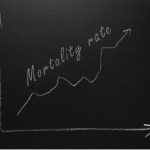NEW YORK (Reuters Health)—Systemic lupus erythematosus (SLE) mortality has declined during the past 46 years in the U.S.—but more slowly than mortality in the general population, according to a nationwide study.
“Based on our experience in the clinic and according to previous reports showing improvement in the short-term (five- to 10-year) survival in lupus, I was expecting to see a greater decrease in lupus mortality rate over time,” Dr. Ram R. Singh from University of California, Los Angeles, tells Reuters Health by email. “So, I was surprised to find that lupus mortality rate has decreased only 24% in a 46-year period, whereas mortality from all other causes has decreased 44% in the same 46-year period.”
“I was most disturbed by the finding that (the) lupus death rate relative to (the) death rate due to all other causes (the ratio) is actually 35% higher in 2013 than in 1968,” he says.
As a result of diagnostic and therapeutic developments, five- and 10-year survival rates for SLE patients improved from less than 50% in the 1950s to more than 90% in the 1980s.
To explore what has changed since then, Dr. Singh and colleagues examined age-standardized mortality rates (ASMRs) for individuals with or without SLE from 1968 through 2013, focusing on trends by sex, race/ethnicity, and geographic region.
The findings were published online Oct. 30 in Annals of Internal Medicine.1
The ASMR for SLE decreased from 0.45 per 100,000 persons in 1968 to 0.34 per 100,000 persons in 2013, a relative decrease of 24.4%.
During the same period, the non-SLE ASMR declined by 43.9%.
The ratio between SLE and non-SLE mortality increased between 1975 and 1998, but showed a sustained decrease after 1998. However, in 2013, the ratio remained 34.6% higher than in 1968.
SLE mortality stratified by race/ethnicity was higher in women than men in all racial/ethnic groups, whereas the adjusted odds ratio (SLE to non-SLE) and mortality differences were largest in non-Hispanic black people and smallest in non-Hispanic white people.
For all racial/ethnic groups, SLE mortality risk was greater in all other geographic regions relative to the Northeast, except for non-Hispanic black persons in the Midwest and Hispanic persons in the South and Midwest.
SLE mortality risk was more than three times higher among patients age 65 or older than among younger patients.
“Non-white persons and older individuals with lupus have a relatively higher risk of death from lupus and may need additional attention,” Dr. Singh says.

